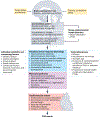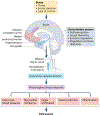Stress and cardiovascular disease: an update
- PMID: 38698183
- PMCID: PMC11872152
- DOI: 10.1038/s41569-024-01024-y
Stress and cardiovascular disease: an update
Abstract
Psychological stress is generally accepted to be associated with an increased risk of cardiovascular disease (CVD), but results have varied in terms of how stress is measured and the strength of the association. Additionally, the mechanisms and potential causal links have remained speculative despite decades of research. The physiological responses to stress are well characterized, but their contribution to the development and progression of CVD has received little attention in empirical studies. Evidence suggests that physiological responses to stress have a fundamental role in the risk of CVD and that haemodynamic, vascular and immune perturbations triggered by stress are especially implicated. Stress response physiology is regulated by the corticolimbic regions of the brain, which have outputs to the autonomic nervous system. Variation in these regulatory pathways might explain interindividual differences in vulnerability to stress. Dynamic perturbations in autonomic, immune and vascular functions are probably also implicated as CVD risk mechanisms of chronic, recurring and cumulative stressful exposures, but more data are needed from prospective studies and from assessments in real-life situations. Psychological assessment remains insufficiently recognized in clinical care and prevention. Although stress-reduction interventions might mitigate perceived stress levels and potentially reduce cardiovascular risk, more data from randomized trials are needed.
© 2024. Springer Nature Limited.
Conflict of interest statement
Competing interests
The authors declare no competing interests.
Figures



References
-
- Brotman DJ, Golden SH & Wittstein IS The cardiovascular toll of stress. Lancet 370, 1089–1100 (2007). - PubMed
-
- Kivimaki M. & Steptoe A. Effects of stress on the development and progression of cardiovascular disease. Nat. Rev. Cardiol 15, 215–229 (2018). - PubMed
-
- Nielsen RE, Banner J. & Jensen SE Cardiovascular disease in patients with severe mental illness. Nat. Rev. Cardiol 18, 136–145 (2021). - PubMed
Publication types
MeSH terms
Grants and funding
- I01 RX003418/RX/RRD VA/United States
- K24 HL077506/HL/NHLBI NIH HHS/United States
- R01 HL125246/HL/NHLBI NIH HHS/United States
- R01 HL136205/HL/NHLBI NIH HHS/United States
- R01 MH120262/MH/NIMH NIH HHS/United States
- T32 HL130025/HL/NHLBI NIH HHS/United States
- K23 HL127251/HL/NHLBI NIH HHS/United States
- UH3 DA048502/DA/NIDA NIH HHS/United States
- P01 HL101398/HL/NHLBI NIH HHS/United States
- UG3 DA048502/DA/NIDA NIH HHS/United States
- KL2 TR000455/TR/NCATS NIH HHS/United States
- R01 HL109413/HL/NHLBI NIH HHS/United States
- I01 CX002331/CX/CSRD VA/United States
- K24 MH076955/MH/NIMH NIH HHS/United States
- R01 HL088726/HL/NHLBI NIH HHS/United States
LinkOut - more resources
Full Text Sources
Medical

